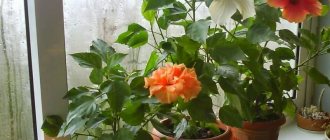Roses Patio: general information
Patio roses were brought to Europe in the 19th century from their homeland, China. They were crossed with floribunda roses. They are also called Miniflora, but this name did not take root in Europe. The mother plant is considered to be a hybrid tea rose.
The description in its current form says that Patio roses are a variety of low-growing bush roses of the Rosaceae family of the floribunda group. The foliage is dense, dark green. They differ in their size - 70 cm in height, some specimens grow only 30-50 cm. When flowering, the bush is strewn with buds, which can be double or semi-double, grow in inflorescences or singly. The flowers have a pleasant aroma and a variety of colors in white, pink, red, yellow or orange.
Patio at its best
Patios are grown in pots or cache-pots to decorate the home, and they are also used to decorate mixborders.
Subvarieties and their photos
Parade
Low plant (40 – 45 cm). Pleases with lush flowering for 5 - 6 months. Then follows a two-month break. Best adapted to home conditions.
Patio hit
The rose belongs to the floribunda group . The stem length is 50 – 55 cm. Large flowers can be of different shades, they even have two-color petals. Blooms long and profusely.
Mini
Dwarf plants (up to 40 cm). The buds can be either small or large in size.
Danica
A small plant about 30 cm high. The size of the petals in a bud is approximately 3 - 5 cm. Their color may vary.
Varieties of indoor plants
- Korsnoda
Border roses - what kind of variety are they?
The bush is compact, maximum size is 60 cm in height. The flowers are double, white and cream in color. Flowering is long and abundant.
- Rose spray Macarena
The bush is compact, the inflorescences are large. The foliage is glossy. The blooming flowers are rosette-shaped and light yellow in color with a brighter center. Over time they acquire a pink tint.
- Pink Flash
Winter-hardy species. Bush 50-60 cm high. Feature: marble color. The flowers are pink in color; the petals have light pink stripes, which change color to a richer pink in the cold.
Use in landscape design
- Typhoon
Bush up to 70 cm. The flowers are small, the color is red with shades of orange. More often grown in pots than in open ground.
- Patio hit
The bushes are compact, 30-40 cm in height. The flowers are semi-double or double, lush, of different colors.
Rose Patio Hit, which is easy to care for at home, is perhaps the most popular variety of Patio in Russia. Moreover, both experienced flower lovers and beginners are trying to grow it.
This is interesting! Those who are new to the flower often make mistakes and write the name together as rose Patiohit, which is incorrect.
Description and characteristics
Having figured out what a patio rose is, it will be interesting to learn about its appearance and features.
This type of rose looks like a small lush bush with a lot of flowers. These bushes are planted both in open ground and in separate pots, which allows you to keep them at home and decorate rooms, balconies, loggias, and verandas with them. The height of the plant is 40-50 cm. The flowers are from 2 to 5 cm in diameter.
A nice feature of the patio rose is that flowering can last for quite a long time. This is facilitated by pruning the plant.
The variety of varieties is impressive. The term "patio mix rose" is often used to describe this rose. The word “mix” in this case means great variability in the appearance of the plant. Another name used for some varieties is patio hit mix rose. There are at least 2000 varieties of this plant. The colors include all kinds of shades of red and pink, yellow, white, lilac, and color combinations.
As breeders continue to work on developing new varieties of patio rose, we can expect the most unusual shades to appear in the future.
Roses Patio: care at home
Rose El Toro - what kind of variety is it?
Roses tolerate drought well. They need a lot of sun, but not in excess. It is advisable for the rose to be in the sun in the first half of the day.
Water the plant as the soil dries. It is advisable to do this rarely, but in large quantities.
The soil is preferably slightly acidic. Fertilizer is applied 3-4 times a year: in the spring - nitrogen, in the summer - phosphorus and potassium.
The size of the pot depends on the variety. Basically, it is required that the container be 30-35 cm deep - this will be enough for the Patio.
Bud close up
Dry or broken stems are trimmed and infected ones are also removed. During flowering, it is necessary to cut off faded buds.
In the first year, it is better not to let the plant bloom until it has become stronger and accustomed to the new conditions.
If you buy a ready-planted bush, it should be transplanted into a suitable container along with a lump of earth, being careful not to injure the roots.
Important! You cannot replant during flowering.
Neat rose bush in a pot
Plant care
In order for the plant to develop normally, it needs to be provided with good care. It should include timely watering, fertilizing, and pruning.
Rose Jubilee of the Prince of Monaco (Jubile du Prince de Monaco) - what kind of variety is it
The rose needs regular and moderate watering. The frequency of soil moistening and the volume of water are selected taking into account the seasonal factor. The lower leaves should be regularly sprayed with warm water.
One of the main rules for caring for roses is the systematic application of fertilizing. Bushes should be fertilized every 2 weeks. You can combine or alternate organic and mineral products.
Before fertilizing, the soil must be well watered. It is also recommended to use special substances for spraying the foliage of the crop. At the same time, you should not overuse fertilizing, since an excess of nutrients activates the growth of foliage and prevents normal flowering.
Important! After flowering has finished, you can use saltpeter or superphosphate. It is forbidden to feed sick or recently transplanted bushes.
Pruning and replanting
The crop should be pruned as needed when the foliage and flowers turn yellow. Bush formation is carried out more often. With the arrival of spring, it is worth getting rid of weak shoots, leaving 5 of the most powerful branches. In autumn you need to prune all shoots.
It is recommended to replant every 2 years. The procedure is carried out by transshipment so as not to damage the root system. In summer you can plant roses in open ground.
The plant requires timely and moderate watering
Features of wintering a flower
In winter, plant care changes. During this period, you should not moisten the soil too much. Otherwise, the rose may rot its roots. A sudden drop in temperature should not yet be allowed.
Important! The rose can hardly tolerate dry air, so it is recommended to place it away from heating sources.
Planting Patio roses in open ground
The variety can be grown both in a pot on a windowsill and in open ground.
Rose Jazz - characteristics of the varietal shrub
Planting on the site is carried out in the spring, when warm weather is favorable for flower growth.
Choose strong seedlings - each should have several leaves and roots.
Important! If the selected seedling already has buds and flowers, they need to be cut off before planting.
You can treat the seedling with a fungicide to prevent fungal diseases and stimulate growth.
Step-by-step landing instructions:
- Dig a hole 20-30 cm in diameter.
- 10 cm of humus is poured into the bottom of the hole.
- When planting a seedling, carefully straighten its roots and cover them with soil, lightly compacting them. The base of the stem after burying should go slightly into the ground.
- The planted seedling must be watered abundantly.
Choose a place that is sunny, but not too sunny: roses love the sun, but too much of it leads to burns. Attention is also drawn to drafts - there should not be any.
The ideal soil is slightly acidic loam. If the soil is different, it needs to be improved - add clay and sand mixed in equal proportions.
Moderate watering is required. A lack of moisture leads to lethargy of the bush, an excess can cause rotting of the roots. It is advisable to water the plant rarely, but abundantly, since the main roots of the plant go deep underground. The owner of a rose bush needs to focus on drying out the soil.
Important! Water the seedlings frequently and abundantly until they take root.
Fertilizer is applied only in the second year of growth. In spring, when leaves are actively growing and buds are forming, nitrogen fertilizers are suitable. But only in spring and summer do they use phosphorus and potassium fertilizers. In total, fertilizing is carried out 3-4 times a year. Complex mineral fertilizers from the store are suitable for these purposes.
Trim the plant in the spring - remove broken and dry stems. In summer, drying branches and faded buds are removed.
At the end of flowering, all stems are cut off - even those that did not produce buds. Before cold weather, the bush is checked for the presence of infected parts: they are removed. The bush itself can be trimmed to the shape necessary for convenient shelter for the winter. Before frost, the rose bush is covered with spruce branches.
Planting a rose bush in the ground
Preparation of soil and planting material
Many gardeners prefer the miniature Patio rose largely because this plant is unpretentious, and it also takes root well, despite the conditions. The crop can be planted and grown in special containers, in pots on windowsills, or in open ground. Before planting begins, high-quality preparatory work must be carried out. So, preparation consists of two key points, namely:
- choosing the appropriate variety and seedlings of the Patio rose.
- choosing a site for planting.
How to make furniture with hiding places with your own hands: all the secret places
After the planting material has been purchased, the seedlings must be washed under warm water to eliminate possible bacteria and microbes. If you plan to plant at home, it is recommended to transfer the seedlings to a large container and then send them to the greenhouse until the optimal time for planting arrives.
Rose Patio actively grows and develops in those areas that are sufficiently illuminated by sunlight, since only the sun can provide bright and abundant flowering. When planted in open ground, seedlings must adapt, so they must be temporarily protected from direct sunlight.
How a rose from the Patio variety blooms
Roses blooming is always an event. Dwarf roses have their own characteristics during this period.
Rose Patio is distinguished by long, abundant flowering - sometimes until frost. During flowering, flowers appear both singly and in inflorescences.
For roses, a dormant period is important so that the plant can rest and recover. At this time, the leaves begin to turn yellow and growth slows down. If the plant is in a pot, it needs to be placed in a cooler place.
Important! When kept in a heated apartment on a windowsill, a period of rest cannot be arranged. The only way out is a glass balcony. To prevent the soil from freezing, the pots are placed in boxes with sawdust.
The buds of the Patio rose are similar to those of the hybrid tea rose, which is considered the mother plant in this chain.
There are three types of flowers:
- simple;
- terry;
- semi-double.
Important! In some species, flowers become flat towards the end of flowering.
The flowers are lush, maximum diameter is 9 cm, and have a pleasant aroma.
Roses blooming on the site
The best varieties
Yellow roses can be grown even in northern regions, the main thing is to choose the right variety of this stunning plant. The table below presents the names of varieties that are distinguished by their beauty and undemandingness.
| Name | Description | Features of care | Resistance to garden diseases and cold |
| "Graham Thomas" | This rose has a unique and pure yellow hue and blooms throughout the summer season. A climbing bush up to 1.5 meters high fills all the space allotted to it, evenly distributing its flowers over arches, arbors or walls | The plant needs feeding and shelter for the winter, and it also needs to be pruned in a timely manner. | The variety is resistant to most diseases. Winter-hardy |
| "Mary Rose" | Yellow rose from the collection of English florist David Austin. The cup-shaped yellow-orange flowers have a delicate fruity aroma and remain neat after heavy rains or drought. Bush powerful, branched | The variety of roses described requires bending down the shoots, as well as constructing a simple shelter for the winter | The bush is susceptible to black spot disease, but is resistant to fungal infections. High winter hardiness |
| Kerio | The bright yellow small rose has a faint aroma. Belongs to the hybrid tea varieties of the flower, the bush is tall and vertical in shape | Needs shelter for the winter and pruning of shoots | Susceptible to most diseases in unfavorable years. Average winter hardiness |
| "Yellow Rose of Texas" | Apricot-colored roses with dense petals. Traditionally used to make bouquets. Bushes are compact, slightly branched | Caring for this variety is the same as for the varieties described above. | High resistance to cold and disease |
| "Golden Showers" | An unpretentious and long-blooming rose, it is famous for its golden flowers with wavy petals. In autumn, re-blooming occurs. The bush beautifully entwines walls, gazebos and other supports | The plant needs a garter, as well as regular feeding and protection from the cold. | Average resistance to cold and garden diseases |
| "The Pilgrim" | One of the most beautiful English roses, the flowers are soft yellow in color and have silky petals. Medium sized bush, erect | This variety of rose requires attention from the gardener. It is necessary to trim the shoots, feed the plant and cover it for the winter. | High winter hardiness and disease resistance |
| "Golden Celebration" | This rose has huge, spherical, amber-colored flowers that emit a strong fruity scent. The bush is spreading, its size directly depends on the climate | Like other varieties, it needs pruning and winter shelter | The bush is susceptible to black spot disease. Winter hardiness is high |
| "Warm Wishes" | The flowers are red-yellow, the bushes are compact. Roses with a spicy aroma bloom from pointed buds and retain their shape for a long time | The plant needs not only care, but also good protection from frost. | The variety is susceptible to freezing in severe winters. Average disease resistance |
| "Arthur Bell" | bright yellow flowers resemble lemon fruits, the bush is tall. In hot weather, roses become creamy, which is their disadvantage | Caring for this variety is the same as for previous varieties of roses. | Average resistance to diseases. High winter hardiness |
| "Rugelda" | The flowers are yellow with red edges and open from scarlet buds. The bush is prickly, reaches a height of up to 2 meters under favorable weather conditions. | Be sure to trim the shoots and feed the plant | Average resistance to cold and disease |
| "Gold Symphony" | The small rose is characterized by golden flowers that bloom profusely until autumn. Grows both in gardens and in pots | Caring for an indoor rose involves timely replanting, watering and feeding the bush, as well as moving the plant to a cool room for the winter. | The variety is resistant to fungal infections, winter hardiness is average |
| "Friesia" | Lemon flowers keep a beautiful shape for a long time, the bush is compact. However, such a rose quickly crumbles, and the interval between flowering is quite long. | In addition to standard care, it also requires good shelter during the cold season. | Average resistance to disease and cold |
Thanks to the collective efforts of specialists, the plant has become unpretentious and resistant to adverse environmental influences.
Flowers that previously had no aroma now have a fruity scent that attracts the attention of connoisseurs of yellow roses.
Flower propagation methods
Patio propagates in two ways:
- cuttings;
- grafting a shoot onto a rose hip.
Reproduction by cuttings
Cuttings are cut at any time of the year. It is believed that cuttings taken in summer take root best. If they are immediately planted in open ground, then they are first placed in water until the first roots appear. If harvested on the eve of winter, the cuttings are wrapped in peat and paper and stored in the refrigerator or cellar.
Reproduction by grafting a shoot onto a rose hip
I advise you to take a frost-resistant rosehip variety, at least 3 years old.
Shoots 5 cm long are cut from the middle part of the rose bush. Important conditions are the presence of buds and well-peeling bark.
The rootstock of the rose is rosehip. The plant is dug up, the stems are shortened to 20 cm and stored in a cool place until spring. Before the procedure, he is examined for the presence of diseases. If there are any, the plant is treated with a solution of clay mash.
Cuttings in the ground
Vaccination can be carried out in the summer, but it is better in the spring. You will need a rose cutting and a rosehip rootstock, on which 2 oblique cuts are made. In this cut, the rose cutting is fixed using grafting tape or strips of fabric. The blanks are placed in boxes.
For quick results, boxes with blanks are placed in a room with high humidity and a temperature of 15-20 degrees. The fusion of the slices will begin in 2 weeks. 3 weeks after planting, the boxes are moved to a warmer place. The rose cutting and rose hip root completely grow together in 1-1.5 months. Then the fixing tapes are removed and the seedlings are planted in open ground.
Important! The seedlings are covered with film on top to create a greenhouse effect and to protect them from the scorching rays of the sun. They'll take it off in a couple of weeks.
Planting and propagation
Many flowers need to be replanted as soon as they get home from the store. The indoor patio rose needs some time to adapt. Due to the tenderness of the root system, you should not shake off the earthen ball when replanting. It is better to transfer the flower by transshipment.
The rose needs annual replanting. To do this, select a pot 3 cm larger than the previous one. A classic shape or a deep pot will do. After this procedure, the flower needs shade for some time.
Much attention should be paid to the soil for the plant. It should be soft and breathable, and allow moisture to pass through well. Loosening a flower is contraindicated for the same reason that the roots are tender. The flower grows well in a mixture of turf, humus soil and sand in a ratio of 4:4:1. Good drainage is important.
The plant propagates using cut branches. Using a knife, cuttings of 15 cm are cut and placed in water at room temperature. A minimum of 4 buds per cutting is required.
After 14 days, the first manifestation of roots is observed, but the cuttings are planted in soil with well-developed roots. Cuttings germinated in autumn do not hibernate; they continue to grow throughout the winter period.
Growing problems, diseases and pests
What diseases can attack roses?
- powdery mildew;
- rust;
- rot;
- leaf spotting.
Pests may appear:
- spider mite;
- aphid;
- leaf roller
For prevention in the spring, the plant is treated with fungicides or a solution of copper sulfate.
Diseased or infected plants are treated with special preparations: Fitoverm, Karbofos, Hom, Topaz. It is also possible to treat with wood ash or horsetail decoction.
Patio roses are not dwarf varieties, but with their miniature beauty they can decorate any garden as a reward for regular care. Flowers look especially beautiful on the windowsill, surprising random witnesses. Caring for the Patio is not too difficult, so lovers of indoor and garden plants should definitely pay attention to this variety.
Border rose varieties, photo
For your consideration, we present some varieties of border group with descriptions and photos:
Orange Babyflor
The flower is bright orange-red, 4 - 5 cm in diameter, double. The leaves are shiny, dark green. Rose bred in 1994 in Germany. Grow in containers, pots, flower beds.
The rose has a pleasant, juicy orange color, the bud is 4 - 5 cm in diameter. It has a light aroma. A beautifully shaped bush 50 - 70 cm high, spreading - 40 cm wide. It blooms profusely and for quite a long time. Resistant to diseases.
Huge flowers, 12 cm in diameter, collected in racemose inflorescences, two-color: cherry-red color harmoniously turns into greenish-white. The buds slowly bloom and stay on the bush. Grow in groups.
Bicolor plant: red with a yellow center. The flowers are collected in inflorescences, 4 - 5 cm in diameter. The height of the bush is 40 - 45 cm. It blooms magnificently until autumn. Does not have high resistance to diseases.
The shape of the flower is similar to tea flowers, 6 - 8 cm in diameter. It has a delicate, romantic white-red hue. Blooms profusely until late autumn. Resistant to frost and disease. Used for cutting.
Gold Sphinx
The bush is large, 60-80 cm in height. It has beautiful creamy-yellow petals, flowers are 5 - 8 cm in diameter, single or collected in brushes, double (50 - 60 petals). It blooms fragrantly for a long time. For cutting, single plantings.
El Toro
Terry, fiery dark red flowers (up to 9 cm in diameter) attract attention at first sight. Have a gentle, unobtrusive scent
Bush - 60 - 80 cm. It has the ability to retain rich color for a long time, “does not fade” even in the scorching sun. Winter-hardy, disease-resistant rose.
Flowers are cup-shaped, white, double, 5 - 8 cm in diameter. Has no smell. The leaves are glossy, dark green. The bush is extensive, 60-100 cm wide.
A fabulous snow-white color, depicted along the edges by a mysterious artist with crimson outlines. The flowers are cup-shaped, up to 6 cm in diameter, collected in inflorescences. Very aromatic. The bush is dense, straight, 60 - 70 cm tall.
On one side of the flower, a crimson tone predominates, which on the other side borders on silver. The buds are 5 - 7 cm in diameter, with a slight odor. Bush - medium, 40 - 50 cm. Blooms for a long time. Resistant to diseases. Used for group plantings.
The impressive, hot pink shade will not leave anyone alone. Flower - 5 - 7 cm, small in height 40 - 50 cm (30 cm in width). It blooms profusely and is also disease resistant. Used in pots, in flower beds, as a border.
Multi-colored (pink, red, white) roses will fill your room in summer and warmth, especially in winter. Propagated by cuttings - from cut thin stems. They have matte, dense leaves. The bush is small, 30 - 40 cm in height. Not bad in borders, pots.
The cheerful, sunny, lemon yellow hue of the flower will transport you to the world of dreams. The bush is compact, 40 cm wide and 50 - 60 cm high. The aroma is light. Flowers 5 - 7 cm last abundantly until autumn. Both in the border and in pots.
How to feed an indoor rose for lush flowering
nic-eda.ru
Indoor rose needs feeding from March to October. During the flowering period, fertilizers must be applied frequently (every 7-10 days or according to instructions) and in small doses to prolong flowering. Spraying can be alternated with root feeding.
You should not feed the rose for the first 1-2 months after purchase, because... she received a sufficient dose even when growing in a greenhouse complex. If you have transplanted a flower, you can gradually apply fertilizer.
For feeding, choose universal complex mineral fertilizers or special ones for roses. You can also add organic matter under the bush: compost (1 tbsp per 1 liter of water) or rotted bird droppings (1 tsp per 1 liter of water). Banana peels, which are rich in potassium, phosphorus, magnesium and other elements, will also help enhance flowering. Just pour a glass of water over the peel of one banana and leave until foam appears. Water the plants 1-2 times a month.
- How to feed indoor plants - choosing the ideal fertilizers for flowers on the windowsill
Do you want your plants to look healthy all year round? Then create the right feeding regimen for them!
How to care for indoor roses in winter
In winter, indoor roses suffer from poor lighting and temperature changes. It is important to provide it with additional lighting for at least 12 hours, reduce watering, and eliminate fertilizing. The room temperature should not exceed 21°C. Place the rose pot away from radiators and regularly mist the air around the bush to increase humidity.
If it is not possible to provide additional light to the plant, then it is worth putting the rose into a shallow “sleep” so that it can more easily endure unfavorable times. To do this, place the flower in a room with a temperature of 10-15°C. In such conditions, the plant’s metabolism will slow down, and it will save energy for future flowering. During the dormant period, the soil should be moist, so do not forget about watering. Fertilizing should be excluded.
Indoor roses love bright, diffused light, moderate watering and cool, fresh air most of all. In such conditions they will bloom magnificently and will not suffer from diseases and pests.
We also recommend that you read how to grow roses in containers.











